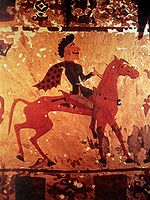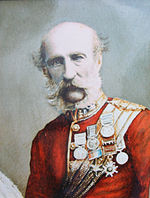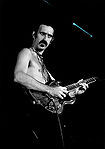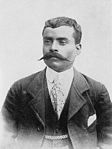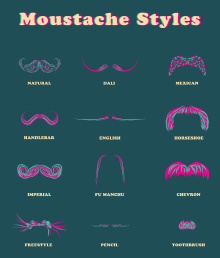- Moustache
-

A moustache (US
 /ˈmʌstæʃ/ or UK /məˈstɑːʃ/; American English: mustache)[1] is facial hair grown on the outer surface of the upper lip. It may or may not be accompanied by a type of beard, a facial hair style grown and cropped to cover most of the lower half of the face.
/ˈmʌstæʃ/ or UK /məˈstɑːʃ/; American English: mustache)[1] is facial hair grown on the outer surface of the upper lip. It may or may not be accompanied by a type of beard, a facial hair style grown and cropped to cover most of the lower half of the face.Contents
Etymology
The word "moustache" derives from 16th century French moustache, which in turn is derived from the Italian mostaccio (14th century), dialectal mustaccio (16th century), from Medieval Latin mustacium (8th century), Medieval Greek μουστάκιον (moustakion), attested in the 9th century, which ultimately originates as a diminutive of Hellenistic Greek μύσταξ (mustax, mustak-), meaning "upper lip" or "facial hair",[2] probably derived from Hellenistic Greek μύλλον (mullon), "lip".[3][4]
History
Shaving with stone razors was technologically possible from Neolithic times, but the oldest portrait showing a shaved man with a moustache is an ancient Iranian (Scythian) horseman from 300 BC.
In Western cultures women generally avoid the growth of facial hair; though some are capable, the majority of these women use some form of depilation to remove it. In rare circumstances, women may choose to embrace this growth, often in the form of thin moustaches. Mexican artist Frida Kahlo famously depicted herself in her artwork with both a moustache and a unibrow. This tradition is followed by some contemporary women in the arts.[5][6][7]
Development and care
The moustache forms its own stage in the development of facial hair in adolescent males.[8] Facial hair in males normally appears in a specific order during puberty:
- The first facial hair to appear tends to grow at the corners of the upper lip (age 11-15),
- It then spreads to form a moustache over the entire upper lip (age 16-17),
- This is followed by the appearance of hair on the upper part of the cheeks, and the area under the lower lip (age 16-18),
- It eventually spreads to the sides and lower border of the chin, and the rest of the lower face to form a full beard (age 17-21).
As with most human biological processes, this specific order may vary among some individuals depending on one's genetic heritage or environment.[9][10]
Moustaches can be tended through shaving the hair of the chin and cheeks, preventing it from becoming a full beard. A variety of tools have been developed for the care of moustaches, including shaving razors, moustache wax, moustache nets, moustache brushes, moustache combs and moustache scissors.
Styles
The World Beard and Moustache Championships 2007 had 6 sub-categories for moustaches:[11]
- Natural – Moustache may be styled without aids.
- Mexican – Big and bushy, beginning from the middle of the upper lip and pulled to the side. The hairs are allowed to start growing from up to a maximum of 1.5 cm beyond the end of the upper lip.
- Dalí – narrow, long points bent or curved steeply upward; areas past the corner of the mouth must be shaved. Artificial styling aids needed. Named after Salvador Dalí.
- English moustache – narrow, beginning at the middle of the upper lip the whiskers are very long and pulled to the side, slightly curled; the ends are pointed slightly upward; areas past the corner of the mouth usually shaved. Artificial styling may be needed.
- Imperial – whiskers growing from both the upper lip and cheeks, curled upward (distinct from the royale, or impériale)
- Freestyle – All moustaches that do not match other classes. The hairs are allowed to start growing from up to a maximum of 1.5 cm beyond the end of the upper lip. Aids are allowed.
Other types of moustache include:
- Fu Manchu – long, downward pointing ends, generally beyond the chin;
- 'Pancho Villa' moustache – similar to the Fu Manchu but thicker; also known as a "droopy moustache", generally much more so than that normally worn by the historical Pancho Villa.
- Handlebar – bushy, with small upward pointing ends. See baseball pitcher Rollie Fingers. Also known as a "spaghetti moustache", because of its stereotypical association with Italian men.
- Horseshoe – Often confused with the Fu Manchu style, the horseshoe was possibly popularized by modern cowboys and consists of a full moustache with vertical extensions from the corners of the lips down to the jawline and resembling an upside-down horseshoe. Also known as "biker moustache".
- Pencil moustache – narrow, straight and thin as if drawn on by a pencil, closely clipped, outlining the upper lip, with a wide shaven gap between the nose and moustache, widely recognized as being the moustache of choice for the fictional character Gomez Addams in the 1990s series of films based on The Addams Family. Also known as a Mouth-brow, worn by John Waters, Sean Penn and Chris Cornell.
- Chevron – thick and wide, usually covering the top of the upper lip. Comedian Jeff Foxworthy and NASCAR driver Richard Petty wear Chevrons.
- Toothbrush – thick, but shaved except for about an inch (2.5 cm) in the center; associated with Adolf Hitler, Charlie Chaplin, Oliver Hardy and Michael Jordan in his commercials for Hanes.
- Walrus – bushy, hanging down over the lips, often entirely covering the mouth. Worn by John Bolton, Dick Strawbridge, Wilford Brimley, Friedrich Nietzsche and Jamie Hyneman.
Notable moustaches
The longest recorded moustache belongs to Bajansinh Juwansinh Gurjar of Ahmedabad, India. It had not been cut for 22 years and was 12 feet, 6 inches long in 2004.[12]
In some cases, the moustaches are so prominently identified with a single individual that it could be identified with him without any further identifying traits, such as in the case of Adolf Hitler. In some cases, such as with Groucho Marx and Charlie Chaplin, the moustache in question was artificial for most of their lives. Kaiser Wilhelm II's moustache, grossly exaggerated, featured prominently in Entente propaganda.
U.S. Air Force ace Robin Olds became celebrated for the flowing handlebar moustache he grew while commanding the 8th Tactical Fighter Wing "Wolfpack" during the Vietnam War, and when forced to shave it by his superior became the source of an Air Force tradition known as "Moustache March".[13]
In art and fiction
Moustaches have long been used by artists to make characters distinctive as with Charlie Chan, Snidely Whiplash, Hercule Poirot, or the video game character Mario. They have also been used to make a social or political point as with Marcel Duchamp's parody of the Mona Lisa which adds a goatee and moustache or the moustachioed self portraits of Frida Kahlo. At least one fictional moustache has been so notable that a whole style has been named after it: the Fu Manchu moustache.
Salvador Dalí published a book dedicated solely to his moustache.[14]
Moustache was the alias name of a French comic actor.[15]
In sport
The Liverpool sides of the late 1970s to late 1980s were famously notable for numbers of moustachioed players, including Mark Lawrenson, Graeme Souness, Bruce Grobbelaar, Terry McDermott and Ian Rush.
For the 2008 Summer Olympics Croatia men's national water polo team grew moustaches in honor of coach Ratko Rudić.
In the early 1970s, Major League Baseball players seldom wore facial hair. As detailed in the book Mustache Gang, Oakland Athletics owner Charlie Finley decided to hold a moustache-growing contest within his team. When the A's faced the Cincinnati Reds, whose team rules forbade facial hair[citation needed], in the 1972 World Series, the series was dubbed by media as "the hairs vs. the squares".
Swimmer Mark Spitz won seven gold medals while sporting a moustache when swimmers usually shaved all their body hair to decrease drag. When other competitors questioned the moustache and the potential increased drag, he claimed that it helped create a pocket of air to breathe.[citation needed]
South African rugby union coach Peter De Villiers also has a moustache, and is derisively known as Piet Snor (Peter Moustache). In 2008 De Villiers was nicknamed "Twakkie" in a public competition held by the South African Sunday Times newspaper - this in reference to a local fictional character with a similar moustache from the SABC's "The Most Amazing Show".
NHL player George Parros is well known for his moustache, of which fans can buy replicas of at the team store, with proceeds going to charity. Parros also has a line of apparel called "Stache Gear" that benefits The Garth Brooks Teammates For Kids Foundation.
Steven Cozza, a professional cyclist from the United States, has found much love from European cycling fans for his horseshoe mustache[citation needed]; facial hair is unusual in the professional peloton.
See also
- Sideburns
- Bearded lady
- Handlebar Club
- American Mustache Institute
- Moustache cup
- Movember
Gallery
Mustache examples British satirist Michael "Atters" Attree sporting his Handlebar Club tie.References
- ^ moustache is almost universal in British English while mustache predominates in American English, except for the third edition of Webster (1961), which gives moustache as the principal headword spelling. Later editions of Webster's New Collegiate Dictionary (from the 1973 eighth edition) give mustache.
- ^ μύσταξ, Henry George Liddell, Robert Scott, A Greek-English Lexicon, on Perseus
- ^ μύλλον, Henry George Liddell, Robert Scott, A Greek-English Lexicon, on Perseus
- ^ OED s.v. "moustache", "mustachio"; Encyclopædia Britannica Online - Merriam-Webster's Online Dictionary
- ^ Matheson, W (2005-12-12). "Let us now praise famous mustaches". USA TODAY. http://blogs.usatoday.com/popcandy/2005/12/let_us_now_prai.html.
- ^ Hoggard, L (2003-11-02). "Who says women can't be sexy with a five o'clock shadow?". The Observer. http://observer.guardian.co.uk/sex/story/0,12550,1075949,00.html.
- ^ "Adrenal virilism". HealthAtoZ.com. https://www.healthatoz.com/healthatoz/Atoz/common/standard/transform.jsp?requestURI=/healthatoz/Atoz/ency/adrenal_virilism.jsp.
- ^ "Adolescent Reproductive Health" (PDF). UNESCO Regional Training Seminar on guidance and Counseling. 2002-06-01. http://unesdoc.unesco.org/images/0013/001304/130431eo.pdf.
- ^ (Chumlea, 1982).
- ^ "The No-Hair Scare". PBS. http://pbskids.org/itsmylife/body/puberty/article7.html. Retrieved 2009-02-20.
- ^ The World Beard & Moustache Championships
- ^ "Longest moustache ever in the world". The longest list of the longest stuff at the longest domain name. http://thelongestlistofthelongeststuffatthelongestdomainnameatlonglast.com/long125.html. Retrieved 2006.
- ^ Byrne, Stacy (2007-03-30). "The facial hair protest is an Air Force tradition". Great Falls Tribune. http://www.greatfallstribune.com/apps/pbcs.dll/article?AID=/20070330/LIFESTYLE/703300320. Retrieved 25 April 2007.[dead link]
- ^ Philippe Halsman & Salvador Dali, Dali's Moustache. A Photographic Interview by Salvador Dali and Philippe Halsman, Simon and Schuster, New York 1954.
- ^ Moustache at the Internet Movie Database
External links
Human hair Body type Facial hair Other areas Hair loss Conditions Related Categories:- Facial hair
- Hairstyles
- Greek loanwords
Wikimedia Foundation. 2010.

